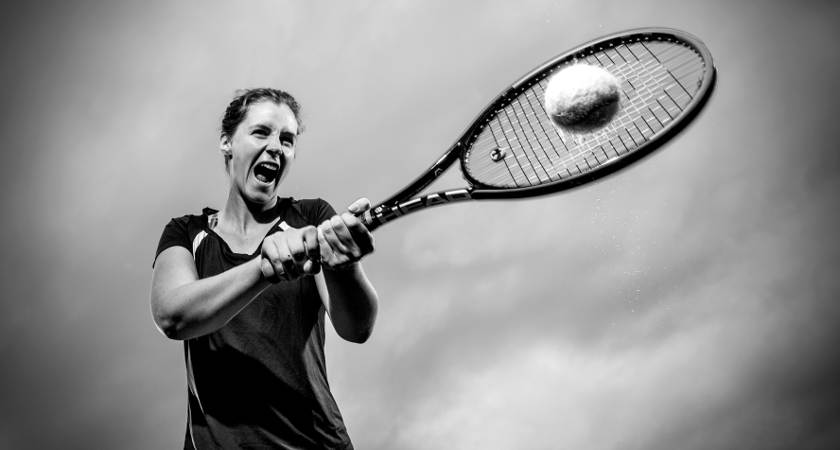1. Ireland has 180 tennis clubs affiliated to national governing body Tennis Ireland, with approximately just as many certified coaches. However, there are some 80,000 club members across the island – that’s 444 members (of which the majority are players) for every one coach.
![Fitzwilliam Lawn Tennis Club in Dublin [Picture: ©INPHO/Donall Farmer]](https://media.irishpost.co.uk/uploads/2016/06/Fitzwilliam-Lawn-Tennis-Club-in-Dublin.jpg)
Fitzwilliam Lawn Tennis Club in Dublin [Picture: ©INPHO/Donall Farmer]
2. Levels of participation are considered to be good, yet just three per cent of adults in Ireland who play sport actually play tennis, according to Tennis Ireland’s latest Strategic Plan.
![[Picture: ©INPHO/Donall Farmer]](https://media.irishpost.co.uk/uploads/2016/06/Tennis-general-generic-N.jpg)
[Picture: ©INPHO/Donall Farmer]
3. Although participation in Gaelic games in England, Scotland and Wales is at an all-time high, it poses no real threat to tennis here, whereas in Ireland the GAA is a considerable rival to rugby and football, let alone little old tennis.
![Croke Park [Picture: Inpho]](https://media.irishpost.co.uk/uploads/2015/09/Croke_Park_GAA_N.jpg)
The lure of Croke Park is too tempting for many kids interested in playing sport [Picture: Inpho]
4. The Irish Sports Council gave Tennis Ireland €525,497 (£432,179) in funding for 2015, putting it 13th in the list of biggest investments out of over 60 sports. Swimming – considered tennis’ biggest threat as an individual sport – got €826,220 (£679,744). It is believed much more investment is needed in order to produce just one top tennis player.
![Swimming received over €300k more funding than tennis last year [Picture: Inpho]](https://media.irishpost.co.uk/uploads/2016/06/Fiona-Doyle-N.jpg)
Swimming received over €300k more funding than tennis last year [Picture: Inpho]
5. In Ireland, it’s almost impossible to become a professional tennis player if you don’t have a private sponsor from a business. Unfortunately for tennis, corporate companies are much more likely to invest in teams rather than individuals.
![A view of the sweat band worn by Ireland's James McGee at the Davis Cup [©INPHO/Donall Farmer]](https://media.irishpost.co.uk/uploads/2016/06/Tennis-wrist-band-tricolour-James-McGee-N.jpg)
A view of the sweat band worn by Ireland's James McGee at the Davis Cup [©INPHO/Donall Farmer]
6. On average, professional tennis players need to travel for 30 weeks of the year, but those without decent sponsorship often have to cover their own travel expenses, with Wicklow pro Amy Bowtell recently having to resort to crowd-funding to cover her costs.

Amy Bowtell, Ireland's former number one women's pro [Picture: ©INPHO/James Crombie]
7. The most advanced tennis nations in Western Europe can afford to budget €75,000 a year per player to support their most talented or promising players. Since 2012, Tennis Ireland have been working to close the gap from their own average budget of just €15,000 per annum per key player.
![Nations like France can afford to back players such as Richard Gasquet from a young age [Picture: Getty]](https://media.irishpost.co.uk/uploads/2016/06/RICHARD-Gasquet-Tennis.jpg)
Nations like France can afford to back players such as Richard Gasquet from a young age [Picture: Getty]
8. The prize money at the lower end of the tennis tour spectrum is an unsustainable income for the lifestyle required of a professional athlete. Ireland’s highest placed male in the ATP rankings is Limerick’s Sam Barry (275), who has earned around £57,000 in his six years as a pro on the ATP circuit – less than £10k per year.
![Ireland's number one player Sam Barry gets by with less than modest returns [Picture: Inpho]](https://media.irishpost.co.uk/uploads/2016/06/Sam-Barry-N.jpg)
Ireland's number one player Sam Barry gets by with less than modest returns [Picture: Inpho]
9. Until 2012, when Tennis Ireland developed a new School Tennis Initiative Programme, the sport was seldom played in state schools across Ireland. Similarly, the National Tennis Academy has only recently been developed in Dublin. It may be some time before Tennis Ireland start seeing a return on these positive steps, but the seeds have been sown at least.
![Fitzwilliam Lawn Tennis Club in Dublin [Picture: ©INPHO/Donall Farmer]](https://media.irishpost.co.uk/uploads/2016/06/Fitzwilliam-Lawn-Tennis-Club-in-Dublin.jpg) Fitzwilliam Lawn Tennis Club in Dublin [Picture: ©INPHO/Donall Farmer]
Fitzwilliam Lawn Tennis Club in Dublin [Picture: ©INPHO/Donall Farmer]![[Picture: ©INPHO/Donall Farmer]](https://media.irishpost.co.uk/uploads/2016/06/Tennis-general-generic-N.jpg) [Picture: ©INPHO/Donall Farmer]
[Picture: ©INPHO/Donall Farmer]![Croke Park [Picture: Inpho]](https://media.irishpost.co.uk/uploads/2015/09/Croke_Park_GAA_N.jpg) The lure of Croke Park is too tempting for many kids interested in playing sport [Picture: Inpho]
The lure of Croke Park is too tempting for many kids interested in playing sport [Picture: Inpho]![Swimming received over €300k more funding than tennis last year [Picture: Inpho]](https://media.irishpost.co.uk/uploads/2016/06/Fiona-Doyle-N.jpg) Swimming received over €300k more funding than tennis last year [Picture: Inpho]
Swimming received over €300k more funding than tennis last year [Picture: Inpho]![A view of the sweat band worn by Ireland's James McGee at the Davis Cup [©INPHO/Donall Farmer]](https://media.irishpost.co.uk/uploads/2016/06/Tennis-wrist-band-tricolour-James-McGee-N.jpg) A view of the sweat band worn by Ireland's James McGee at the Davis Cup [©INPHO/Donall Farmer]
A view of the sweat band worn by Ireland's James McGee at the Davis Cup [©INPHO/Donall Farmer] Amy Bowtell, Ireland's former number one women's pro [Picture: ©INPHO/James Crombie]
Amy Bowtell, Ireland's former number one women's pro [Picture: ©INPHO/James Crombie]![Nations like France can afford to back players such as Richard Gasquet from a young age [Picture: Getty]](https://media.irishpost.co.uk/uploads/2016/06/RICHARD-Gasquet-Tennis.jpg) Nations like France can afford to back players such as Richard Gasquet from a young age [Picture: Getty]
Nations like France can afford to back players such as Richard Gasquet from a young age [Picture: Getty]![Ireland's number one player Sam Barry gets by with less than modest returns [Picture: Inpho]](https://media.irishpost.co.uk/uploads/2016/06/Sam-Barry-N.jpg) Ireland's number one player Sam Barry gets by with less than modest returns [Picture: Inpho]
Ireland's number one player Sam Barry gets by with less than modest returns [Picture: Inpho]
